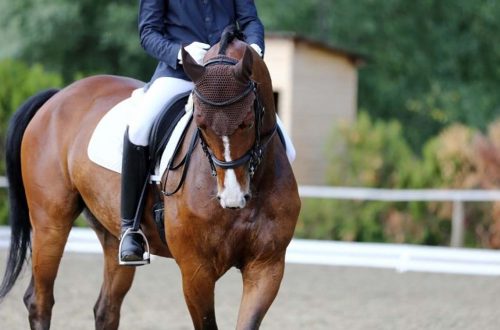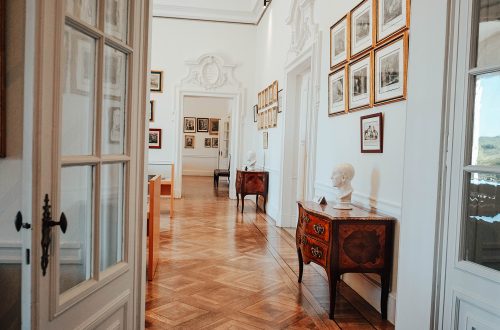
Christina Wunderlich: Passing on Classical Riding with Vertikal
Working dedicatedly to share her passion and spread the knowledge of classical dressage, Christina Wunderlich is a sought-after trainer and teacher, and the head rider at Oliveira Stables, the now well-known classical stable located in the epicentre of the modern dressage world in southern Germany.
With a highly approachable, direct manner and a tireless sense of humour, Christina specializes in training students and horses in what is called Vertikal, a system of classical riding passed on by the teachings of Portuguese rider Manuel Jorge de Oliveira.
This type of classical riding, influenced by both the dressage methods of classical masters including François Baucher and Nuno Oliveira, and methods used in tauromachic or bullfighting riding, focuses on bringing the horse into a state of “vertical” balance. By training the horse to become flexible, and carry more weight over engaged hindquarters, over time the horse can achieve a classical state of balance wherein the horse elevates its forehand, and becomes light and agile in order to begin, shift, or modify any movement at any time.
In the past few years, Oliveira Stables has also begun using Vertikal to rehabilitate competitive warmbloods, as this technique carefully conditions and enables the horse to use its body in a healthy way. Christina and the team at Oliveira Stables have been able to retrain these horses, which had fallen out of modern dressage and show jumping due to having difficult physical or temperamental issues related to their previous work, to become healthy and sound again, and to go on to work daily at a Grand Prix level.
Surprisingly, despite her ability, Christina never planned on becoming a professional rider — she had instead studied to become a veterinarian, and completed her degree of veterinary medicine at the University of Munich.
However, after developing her riding with Manuel Jorge and much dedication, Christina was asked to step into the position as head rider at Oliveira Stables, and has since been instrumental in its growth and the dissemination of classical riding knowledge.
Christina has a way of pin-pointing key issues, clearly explaining how to improve them, and encouraging riders to put their everything into bringing out the brilliance in each horse.
While often very busy between riding, teaching, and leading the riders of Oliveira Stables, I was able to sit down with Christina to hear about and share her insights about her story, her work, and Vertikal, and what makes it unique.
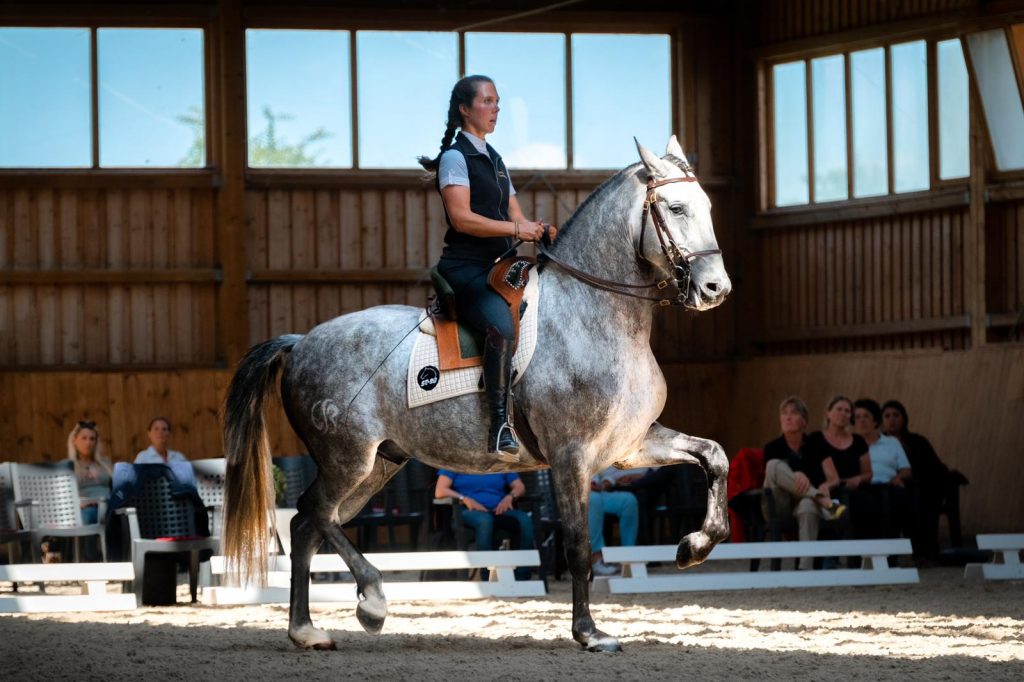
Photo by Patrick Pichler.
Christina’s Story
Before meeting Manuel Jorge de Oliveira, Christina grew up as an ambitious amateur rider. She started riding when she was 9 years old in an English riding school, but quickly took up Western, and even competed locally.
When her mother — also a rider — fell in love with Lusitanos and switched to classical dressage, her mother met and began working together with Anja Beran. It was at an event Anja had held where Manuel Jorge was riding, that Christina then saw him for the first time. She recollects;
“…when I saw Manuel riding at that event I thought “wow, this is riding.” […] I thought “wow, he is riding completely without any aids” — it looked like – the horse was beautiful underneath him, and it looked like he was doing nothing.”
After this experience, Christina looked to start her young Appendix mare in classical training, but heard that because of the mare’s breeding, that she wasn’t ideally suited to classical dressage.
Thinking that she couldn’t pursue classical work with her Appendix mare, Christina shifted back to Western and then to dressage, becoming a student of Gerd Heuschmann’s. While now Christina critiques many common dressage practices including working the horse long and low, she reflects that;
“I did a lot of low, forward and down (long and low). It’s what you learn, and at first you don’t question that. And at first it sounds logical, at first you think “Of course, it’s a bridge, and when you put the front down the rest comes up, then the horse works with the back.””
She understands this mechanism of working the back very differently now. Vertikal training particularly focuses on not overburdening the forehand with the head and neck lowered, but rather on engaging the hindlegs to carry more weight such that the back can round with the forehand elevated. While being typical of correct classical training, this also preserves the health of the fore legs and hooves by lightening their stress load.
When her mother began organising clinics with Manuel Jorge around Germany, Christina went to audit, and she happened to watch Manuel Jorge giving lessons to two riders on Icelandic horses. This critical moment showed her that for this type of training, it didn’t matter what breed of horse she had. She says;
“I thought, if they can do it with their Icelandic horses, then I could also do it…I didn’t have a great big Lusitano or a Warmblood or something, I just had my Thoroughbred Quarter Horse mare.”
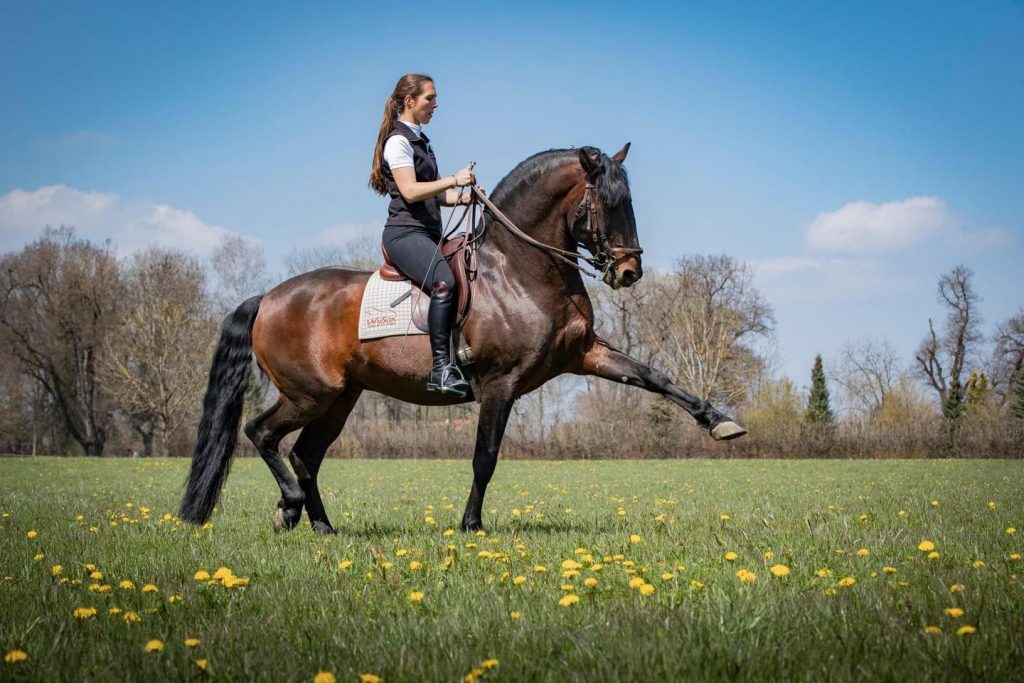
Photo by Gudrun Muschalla.
This can be seen as one of the most notable aspects of Vertikal — that horses of various breeds can be seen successfully practicing and benefitting from the work. From Lusitanos and sport Warmbloods, to Arabians, Icelandic and Criollo horses, and even the odd Percheron — all can be seen to develop physically to become stronger, more flexible, and to move in a better balance with Vertikal work.
After this pivotal clinic, Christina finally began:
“Then I asked if I could have a lesson with Manuel, and then it all started… I followed him very closely. Every time he was in Germany, I always loaded up my horse and went to the clinics, so I did a lot of driving with [my mare] Hanky Panky, and I went to all the clinics with Manuel with her.”
Christina also took the opportunity to further learn in Portugal at Manual Jorge’s stud farm, Coudelaria Oliveira Martins;
“I had the idea that I could just visit Portugal for two weeks. I went and when I was there, my attitude and my riding changed so much in those two weeks that I just wanted to go back, and then my stays there got longer every time.”
When you practice this kind of riding, it goes to your heart because without your heart you cannot do it — you need a lot of feeling, and you have to rely a lot on your feeling. You cannot just say, “Ok, I have to put the head down and go forward.” You have to have a lot of feeling for the asymmetry of horse, the type of horse that you have, the energy that the horse needs, or the rhythm that the horse needs, as it is so individual. Of course, all the horses [we have] do shoulder-in, all the horses do travers, but the question is not what movement you do, the question is how you do it.
Christina Wunderlich
When Manuel Jorge brought a horse to Germany to perform with at events, to Christina’s surprise he asked her to ride the horse whenever he was away in Portugal. She explains that;
“This was really my big chance. Manuel really gave me a big opportunity.”
As she began to ride more and more, and get feedback from Manuel Jorge, she continued to develop as a rider. Then, when her mother established Oliveira Stables in 2015, Christina began as simply a rider. However, within a few years, at a time when no other head rider could be found to continue leading the stables, Christina became its head rider, and has been ever since. She says;
“My plan was never to be at the front of Oliveira Stables, or to give as many clinics as I do now – it was never my goal. Basically, I wanted to be a vet!”
However, while it was never her goal, she has become a cornerstone of Oliveira Stables, inspiring and teaching many horses and riders, to discover how much more there is to riding and to understand how to bring out the best in the horse.
When I asked about her work and about Vertikal, this is what she shared:
Oliveira Stables has grown a lot, and has inspired a lot of people. What do you think it is about this type of riding that seems to inspire more people than other types of riding?
Because it gets more to your heart. Because you’re not looking for goals like winning medals. When you practice this kind of riding, it goes to your heart because without your heart you cannot do it – you need a lot of feeling, and you have to rely a lot on your feeling. You cannot just say, “Ok, I have to put the [horse’s] head down and go forward.” You have to have a lot of feeling for the asymmetry of horse, the type of horse that you have, the energy that the horse needs, or the rhythm that the horse needs, as it is so individual. Of course, all the horses [we have] do shoulder-in, all the horses do travers, but the question is not what movement you do, the question is how you do it.
What do you think are the most important lessons you’ve learned from Manuel Jorge?
Corners! My first lesson with Manuel was only about corners, and I think it was one of the most important lessons of my life.
Also, doing things even if you are not sure if you or your horse can do it. Being more free in the mind – I learned this with Manuel… not to be stuck in the mind but to be free and flexible, and to just do things without really thinking about it.
And then the asymmetry – I think I only really understood this when I was with Manuel. I’m not saying that I understand it completely – I think this is something that you need a lot of years of experience with, and with different horses to really understand it, but so far as I have understood it, until now it was Manuel who taught me.
Also, the energy. I think Manuel, and also his way of riding really made me develop my personality, which was not possible before. Only Manuel and his way of riding and giving lessons, and his way of sometimes just not thinking about if the person who he’s working with is really an experienced rider or not – he just gives you the capacity to do things and that’s made me, I think, another person.
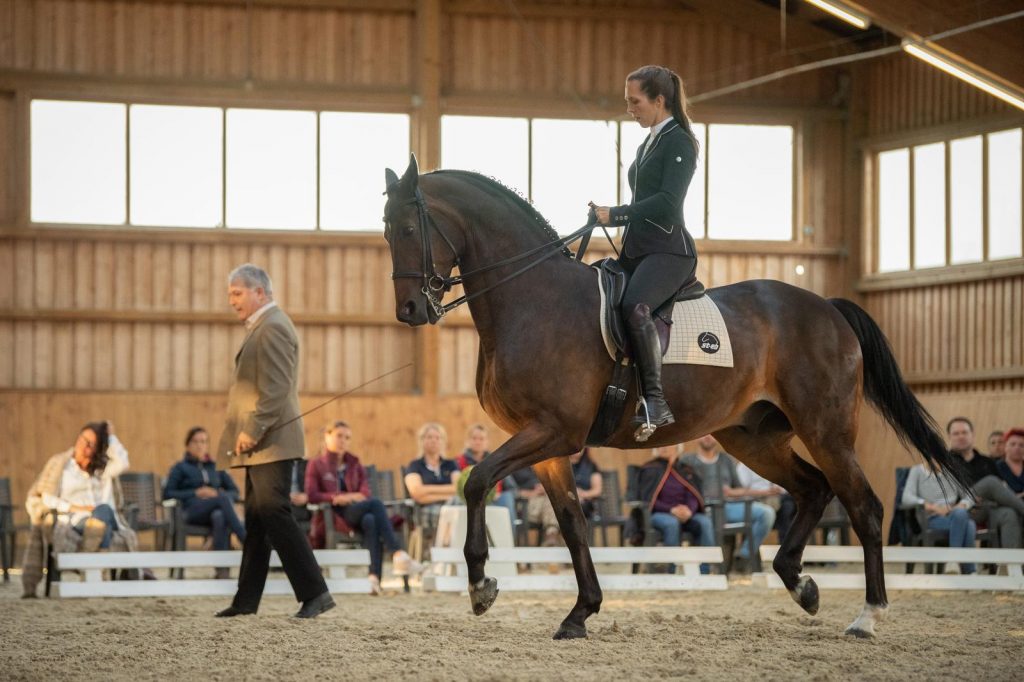
Photo by Klaus Trotter.
Yes, we’ve talked before about how it can make you develop a lot as a person. Could you talk a little bit about why you think that is?
Why is it like that? That’s a very difficult question. I think it’s because you have to go into your feelings, to do what we are doing. You cannot just blame it all on the horse. You cannot say, “Yeah, well, the horse is just stupid and that’s why he doesn’t do it.” It’s more like, “Where’s my mistake; what am I doing wrong? Do I have the correct line, do I have the correct rhythm, do I have the correct position, am I using the correct amount of leg; the correct amount of rein, or is my seat in the middle?” All of these things. So, you have to reflect on yourself a lot more than you do in other types of riding, I think.
When you look at today’s sport horses and especially in dressage, what do you think are the biggest issues?
It’s the focus. They are focused on winning. And I think the image of, or focus of a lot of exercises is just wrong. So, the image that is then published and that people love is wrong. And I think the biggest problem is the ambition to try to put the horse and the rider into a perfect frame. That is, in their world, the same for every horse. So, there is no room for individuality, neither for the horse nor the rider. So, all the riders have to have the “perfect seat.” They all look the same.
For the horses it’s the same, they all have to have the same head position, the same outline. The position for example in piaffe, sometimes you see a picture of piaffe and people applaud and they say, “Wow, it’s such a great piaffe,” and I think it’s completely lost, the idea of dressage and how it was in the times for example of Baucher, when this was all changing.
Because it was really in the time of Baucher when the big change came. Before, the classical approach, so the more academic approach, let’s say, was much more common than the other approach. The other approach, the English or the Anglo approach only came after, only came over from England basically, where they didn’t have many enclosed arenas. So, they were riding a lot of the time outside in the country, and that’s where all the speed and the trotting up and all these things [now common in modern dressage] come from.
Another thing is time – one of the biggest problems today in dressage is time and money. They want the horse to be really fast in [showing] spectacular movements.
The other day, I was watching an online auction of dressage horses and they were all 3, 4, 5 years old, and they were moving the 4-year-old horses like a 10 or 12-year-old horse – so these horses have no time. They cannot accept that the horse that is 3 or 4, of course when it starts ridden work doesn’t look like a 12-year-old horse, and shouldn’t. It should be young!
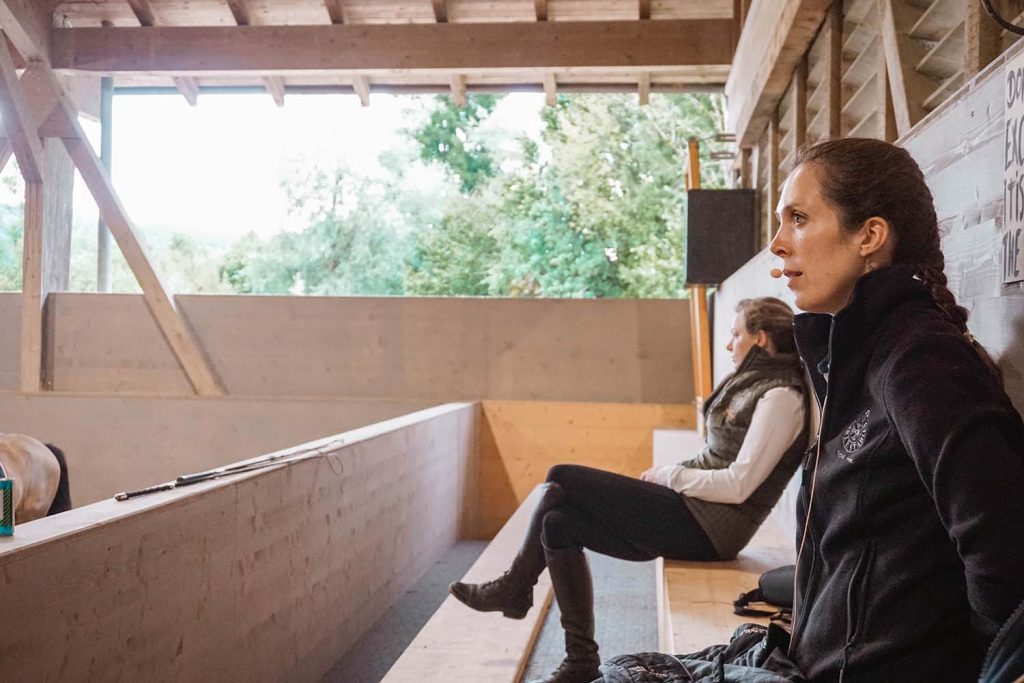
With your veterinary training, obviously you have a good physiological understanding of the horse as well. Could you talk a little bit about the health effects of Vertikal you’ve seen on the horses, and about your work using these methods on rehab horses, especially on dressage warmbloods and how that impacts them?
One part is the energy. Because if you work a horse in the Vertikal way, you will create energy on the horse, and a lot of illnesses have their origin in a lack of energy. When the horse’s energy cannot go and circulate, the energy gets stuck somewhere and then you get health problems – all kinds of syndromes, lameness, and all these things. The energy is one part, so the more energy, the healthier the horse.
The second part is the way that the horse’s body is free from bad tension – you have positive tension of course, but [the horse is] free from bad tension, so [meaning chronic muscular] contractions. The contractions lead to health problems. When you have contractions, you can get tendon damage, because when you have [chronic] contraction of the muscles, the tendons are also [put] under stress and stretched, and when the horse does a stupid step to the side, then of course the tendon at some point goes, for example.
As we also try to put the weight more on the hind end, we take away the weight from the front, which reduces the danger of problems of the front legs, which are more common than problems of the hind legs.
In rehab horses, it’s just the same, basically. Some of these horses are either completely dangerous, or completely dead in the mind. And in both cases, of course you have to mobilize the horse, get the horses flexible, do a lot of flexions, train the piaffe and all these things to try to get the energy moving and try to take away the contractions.
You have to always imagine energy as something that you collect in yourself, or with you and your horse, and this can be in a very, very, very slow walk, or even at the halt. A good halt is something very energetic, because the energy doesn’t go away – it’s very concentrated. So, when you always move with your horse in such a way that at every moment you could pick up a canter or do a pirouette – in every moment you can do everything you want, without having to prepare, then you have a good energy, because then the energy is always in your circle with the horse.
Christina Wunderlich
You were talking about energy, and some could interpret that as just going faster. Could you describe what you mean by energy?
That’s a good question, because a lot of people think that energy is only [going] fast; that’s true. You have to always imagine energy as something that you collect in yourself, or with you and your horse, and this can be in a very, very, very slow walk, or even at the halt. A good halt is something very energetic, because the energy doesn’t go away – it’s very concentrated. So, when you always move with your horse in such a way that at every moment you could pick up a canter or do a pirouette – in every moment you can do everything you want, without having to prepare, then you have a good energy, because then the energy is always in your circle with the horse.
I think that’s very important to say, so of course a fast gallop can be really energetic, but a fast gallop can also be really without energy at all. So, all these riders that are pushing their horses to big movements every day, most of those horses are completely without energy. They run and they go but they are completely without energy. On the contrary, when you put the horse in a very, very slow movement, when you do it well, the energy rather increases than decreases. So, you get more energy like that, which you can then use to go to a fast movement, or you can also use it to go to a very collected movement like piaffe, or passage, or pirouette.
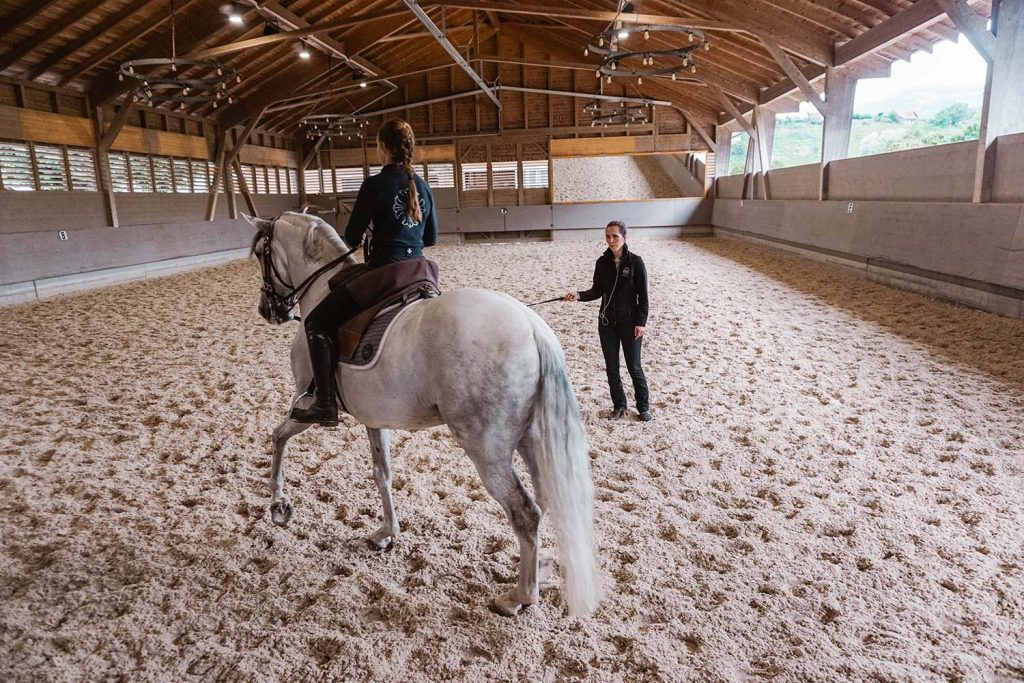
Exploring her work
Since beginning her journey in classical dressage, Christina has continued to evolve in her riding and teach at Oliveira Stables. She has co-authored four foundational books on Vertikal (Vertikal 1-3 and Alta Escola), and has given clinics and programs in Germany, Switzerland, Austria, and the UK.
Christina is passionate about sharing the knowledge of classical riding, and has become instrumental in inspiring riders to deepen their knowledge of the art of classical dressage. Amidst the heart of today’s dressage world in Germany, she studies and teaches another system of riding – one that brings forward insights of academic dressage that create a distinct energy between horse and rider, which helps horses work in lightness, and stay healthier throughout their careers.
If you’re curious about learning more about Vertikal and learning with Christina, you can read the first of the books she co-authored, Vertical 1 in English, train with her online, in a clinic or at Oliveira Stables, or visit one of the events at Oliveira Stables such as the summer Feira. Christina also co-teaches a 3-year intensive course called the Escola de Equitação, both in Germany and in Switzerland.


